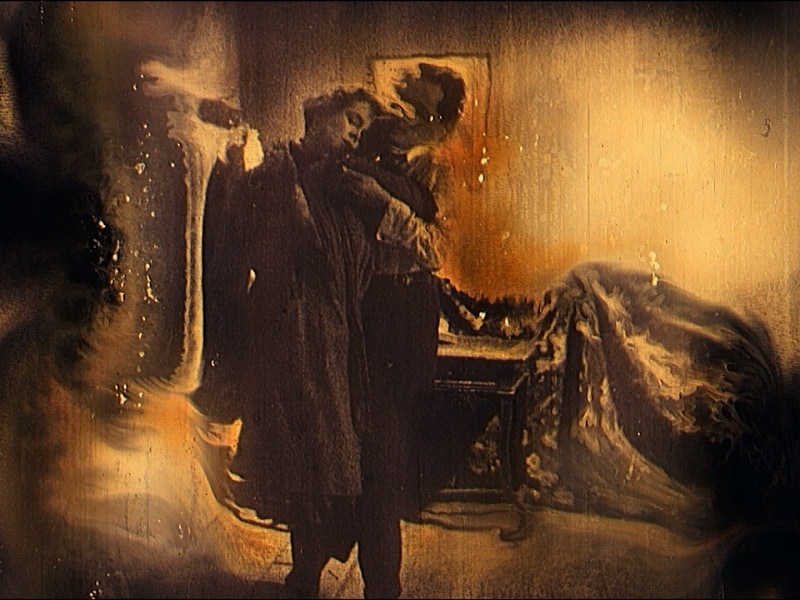
For many old film lovers, nitrate degradation of a rare film is a nightmare scenario. For filmmaker Bill Morrison, it’s an opportunity for new art. Morrison has been reusing found footage of antique film stock beyond the point of restoration for years, including in Dawson City: Frozen Time and the first 21st-century film to be inducted into the National Film Registry Decasia. His latest short film, let me come in, has its television premiere during TCM’s Classic Film Festival, celebrated virtually on TCM and HBO Max simultaneously. let me come in is yet another great example of Morrison’s ability to make something beautifully eerie out of ruins while appreciating the original film in the process.
In 2012, a treasure trove of nitrate films was found in a Pennsylvania barn, the kind of wild discovery that seems impossible but not unfamiliar to Morrison. Included in the discovered films was a presumed lost German silent feature Pawns of Passion, also known as Liebeshölle, from 1928. It sat in the Library of Congress’s Audio Visual Conservation Center on the Packard Campus with Morrison’s name on it, awaiting the right moment. Several years later, composer David Lang approached him to make accompanying visuals for an original song commissioned by LA Opera and the Fisher Center at Bard College. Immediately after hearing Lang’s song, Morrison knew that this forgotten German movie would be the perfect visual representation of Lang’s words and vocalist Angel Blue’s beautiful performance.
In the original Pawns of Passion, a Russian ballerina, played by Olga Tschechowa, searches for her son in Europe to no avail. Defeated, she reaches Paris and attempts suicide by jumping into a river, but an artist rescues her from the water and brings her home. This context is not included in let me come in, which begins with the man ushering a woman inside what looks like his home. She struggles to walk and looks sick, but he continues to guide her upstairs and into bed. Without the context of the original film, the two look like lovers. Lang’s song amplifies this impression as the lyrics display on the screen, and Blue sings, “I dreamt / my lover knocked at the door / I sleep / but my heart is awake.” This scene is no longer within the confines of an original plot of Pawns of Passion but freed into a brand new story.
Lang’s song, which describes a lover knocking on a woman’s door while she remains asleep, is only one aspect that creates a new interpretation of the original nitrate footage. Time and less than ideal storage has caused the Pawns of Passion film to decay, its images melting and warping into unrecognizable pictures. As let me come in continues, we lose sight of the characters at points thanks to the deterioration of the film, but what ends up is more beautiful than one could imagine a trashed film could be.

Lang’s song describes an unreachable love affair, one that can only be experienced in a dream but feels so real you think you’re awake. This fleeting and melancholy description of love goes hand in hand with the images on-screen. Morrison includes footage where the audience can only the outlines of the lovers from the pools of decay. The characters move across the screen, but what they do, we cannot completely tell.
Then, the film cuts to a different scene, one with noticeably less decay in the beginning. Here, the two people appear to have finished dinner or drinks, and the man convinces the woman to slow dance with him. They glide across the frame together and he kisses her on the forehead in a tender moment, but the picture quickly erodes again and their faces warp together and apart again. The woman appears to pull away, and they speak to one another, but with no title cards or a clearer look at their lips, the specifics are lost to us. This scene feels like a memory that’s fading quickly with only the emotions and outlines to remain.
The end of let me come in shows the woman alone in the house where the couple was once together, clinging to each other. She seems to cry, and the song ends by revisiting the sound the lover made on her door while she slept and her heart was awake. It feels like the love is gone and faded into oblivion, like much of the decayed portions of Pawns of Passion. However, the man returns, and the woman lets out a sigh of relief, for it was not all a dream.
This gorgeous rumination of a film results from a tragedy, the loss of yet another silent film reel we could likely never see again. Yet, Morrison sees the opportunity in these ruining images and creates new meaning in them. He’s able to comment on love and memory thanks to nitrate degradation, not despite it. Disposing of or simply hiding away remnants of old films like those used in let me come in would feel like such a waste of a portion of film history, of which we’ve already lost an estimated 75% and counting. Morrison does not try to modernize the film or destroy it to make something new, but finds a way to allow the audience to make different conclusions of what we can get out of these images as they are, in their decaying state. In a way, Morrison allows the film to speak for itself, creating something visually stunning on its own but amplified with music like Lang’s.
TCM‘s viewers are used to relishing in the films that have survived the test of time, but the addition of Morrison’s found footage film rounds out a varied festival lineup. Viewers get to see what happens to their favorite old films when they are not properly taken care of by preservationists and how they can be recycled and turned into something beautiful if they do rot. let me come in airs on TCM at 3:15 AM EST on May 7th, and you can find more information about the complete schedule of films here.
Related Topics: Film Festival, Short Films, TCM

